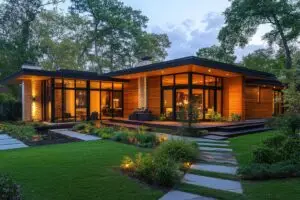Keen to create that dream garden room without moving or extending your home? Maybe you’re thinking about a home office, a playroom, or even a peaceful studio retreat. No matter the purpose, building a garden room can provide that much-needed extra living space, and it’s easier than you think! Before you start building, from Sarah Barlow, Managing Director at Heritage Garden Studios, here’s everything you need to know.
Choose your location
Before you dive into construction, carefully consider where your garden room will sit. Sarah explains, “Our most popular starting size for a useful additional room is 4m x 3m. It’s a flexible, comfortable size for a variety of uses.”
Need a bit more space? “A 14 square meter room works great for a double-desk office, a few pieces of gym equipment, or even a small kitchenette alongside a sofa bed,” Sarah adds. Always check the total size of your garden because regulations often restrict your new garden room from covering more than 50% of your original garden space.
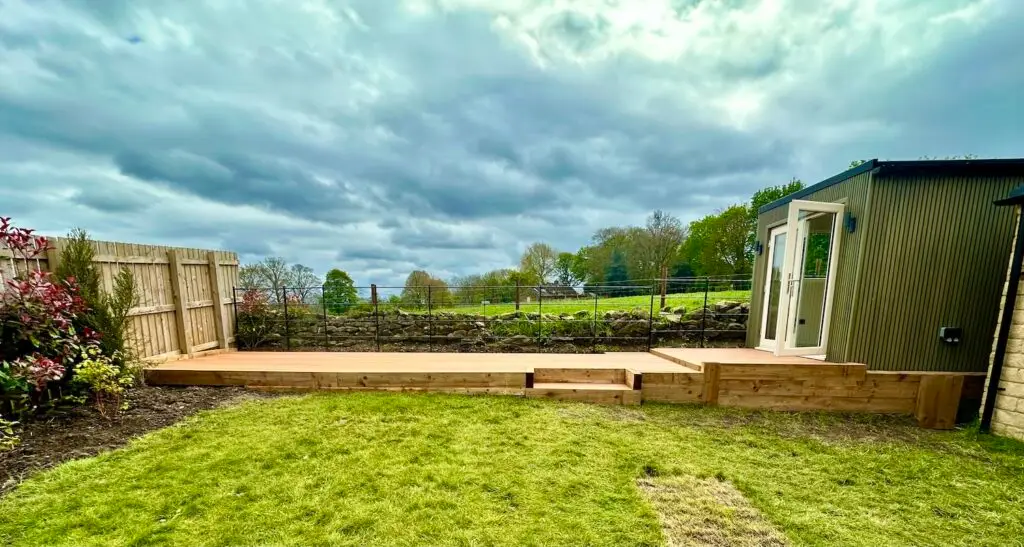
Related: The Best Outdoor Furniture for Your Garden Room
Don’t Discount Small or Awkward Spaces
Think your garden’s too tiny? Think again! “We’ve worked with awkward and small spaces and managed to create stunning, functional rooms,” Sarah says. “Even a 3×3 meter space can be transformed into a practical office, gym, or kid’s room.”
Do you have a weird-shaped garden? No worries. “We’re experienced in building unusual-shaped rooms that fit perfectly into tight corners,” Sarah adds. So, whether your garden is narrow or oddly shaped, there’s still potential.
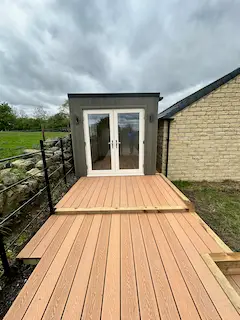
Set Your Budget Early On
Garden rooms come in all shapes and price points. “You can find simple sheds starting at around £2,000,” Sarah shares, “but for a permanent, high-end garden room, expect to spend at least £20,000 to over £100,000, depending on the size and specifications.”
Sarah emphasises setting a clear budget early. “With Heritage, our bespoke garden rooms start around £20,000. If you’re looking for a luxury build, with insulation and custom designs, you’ll need to plan your budget accordingly.”
Know Your Planning Permissions
Don’t overlook this step! “Many garden rooms don’t require full planning permission,” Sarah notes, “but there are exceptions. You don’t want any surprises, especially after making a big investment.”
Sarah advises consulting with professionals or even contacting your local planning department. You can also find excellent advice on the Planning Portal to ensure your project is fully compliant.
Understand Building Regulations
Just like with planning permissions, building regulations can be tricky. “For smaller buildings (under 15 sq m), regulations are usually minimal,” Sarah explains, “but once you go bigger, especially over 30 sq m, things get more complicated.”
Safety first—any electrical work must be certified. And remember, additional approvals are required if your room will be used by the public or for living purposes.
Related: How to Ensure Electrical Safety in Outdoor Structures
Decide Its Purpose
What will your garden room be used for? The possibilities are endless! “Many clients want a multifunctional space,” Sarah says. “It might be a home office by day, a family room in the evening, and an entertainment hub on the weekends.”
Want to future-proof your room? Adding a small bathroom, like a wet room, can extend the usefulness of your garden space.
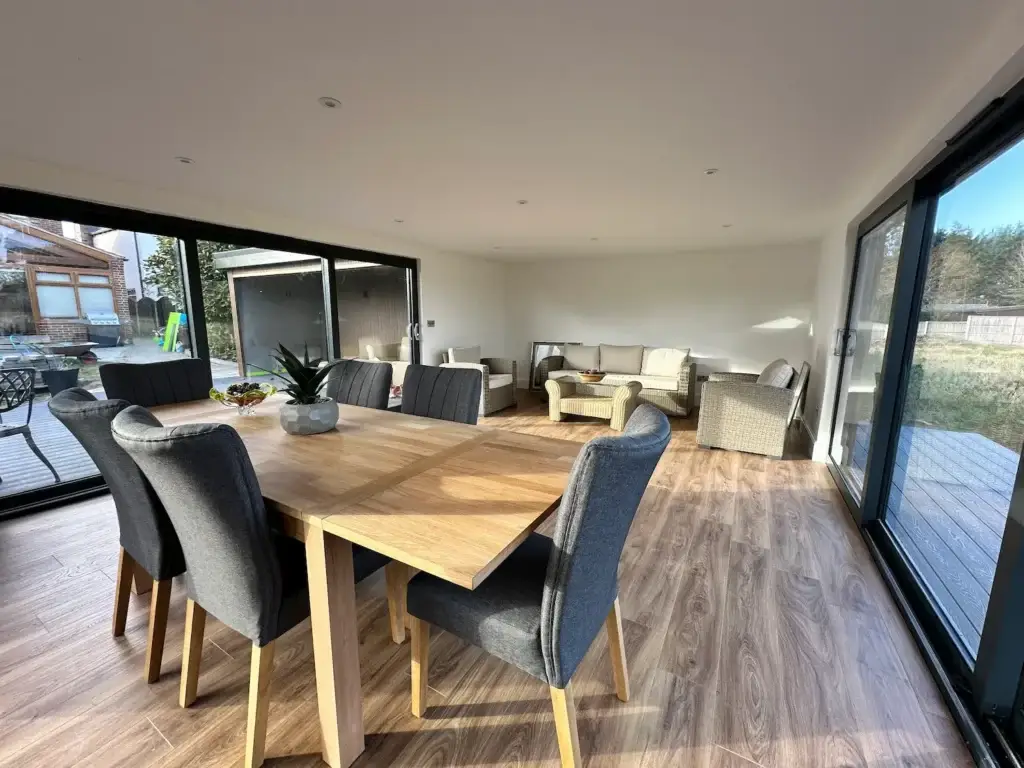
Call in the Experts
If you’re handy, you might consider a DIY approach. “There are companies that offer flat-pack garden rooms for self-installation,” Sarah says. However, if you want a garden room that’s built to last, using professionals is your best bet.
“We provide fully bespoke rooms that are designed and built to your specific needs,” Sarah adds. “We focus on quality, ensuring each room is insulated, decorated, and built to residential standards.”
Related: Flat-Pack Garden Rooms: Are They Worth It?
Discuss the Structure
Sarah highly recommends using Structural Insulated Panels (SIPs) when constructing your garden room. These panels are designed to offer exceptional thermal efficiency, meaning they help maintain a comfortable temperature inside your space throughout the year. “With SIPs, you’ll find that your garden room stays naturally warm, reducing the need to turn up the heating even during the cold winter months,” Sarah explains.
But it’s not just about insulation. SIPs also offer incredible strength and durability, making your structure more robust and long-lasting. Additionally, SIPs can significantly speed up the build process. Since they come prefabricated, construction can be completed much faster compared to traditional methods. This combination of thermal efficiency, strength, and quick installation makes SIPs an excellent choice for anyone looking to build a garden room that’s both high-quality and energy-efficient.

Foundations Matter: Heritage’s Preference for Ground Screws
One of the most critical decisions in building your garden room is the foundation. At Heritage Garden Studios, we favor ground screws for their environmental benefits and ease of installation. “Ground screws cause minimal disruption to the garden, require no heavy machinery, and offer excellent durability,” Sarah explains.
However, depending on your soil and build type, there are several other options to consider:
• Concrete slabs: Ideal for larger, heavier buildings but more invasive to the garden.
• Mini piles: These are driven deep into the ground, reaching firm soil for better stability.
• Helical screw piles: Excellent for supporting significant loads and challenging ground conditions.
“We prefer using ground screws because they don’t involve digging or pouring concrete, and they’re much quicker to install,” Sarah says. “But we’ll always recommend the best foundation based on your site conditions.”
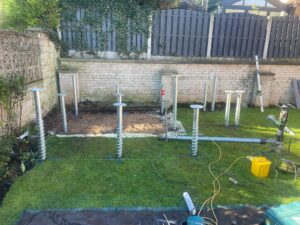
Choose the Right Roof
Gone are the days of leaky garden sheds! Sarah suggests a high-performance rubber membrane for the roof, but if you want an eco-friendly twist, consider a green roof. “Sedum roofs are fantastic for an eco-look,” she says. They also add extra insulation.
Related: Benefits of Green Roofs for Outdoor Buildings
Select Quality Exterior Cladding
“The exterior should blend with your garden,” Sarah says, “and we love using cedar and larch for our garden rooms. These woods are durable, maintenance-free, and naturally resistant to damage.”
Alternatively, composite cladding offers a low-maintenance option that’s growing in popularity. “It’s durable, aesthetically pleasing, and doesn’t require much upkeep,” Sarah explains. Check out more about composite cladding here.
Flooring: What’s Best?
When it comes to flooring, engineered wood is the gold standard. “It’s perfect for underfloor heating,” Sarah notes. If that’s not in your budget, she recommends laminate or rubberized flooring, depending on your intended use for the room.
Factor in Electrics
A fully functional garden room needs reliable power. Sarah emphasises the importance of proper wiring for heating, sockets, and lighting. “You’ll need a new power feed to accommodate all the electrics,” she says.
Internet is another must-have. “We can hardwire internet cables from your house to the garden room to ensure a solid connection,” Sarah adds.
Heating Options
Even with good insulation, a garden room will need heating during colder months. Sarah suggests several options, including electric radiators, underfloor heating, or even air conditioning. “Air conditioning is a luxury but works efficiently for both heating and cooling,” she explains.
Final Thoughts from Sarah Barlow
Building a garden room is an excellent way to add value, space, and functionality to your home. Whether you’re looking for an office, a gym, or a multifunctional space, there are endless design possibilities. With careful planning and the right expertise, your garden room can become a valuable part of your lifestyle.
Looking to start your project? Reach out to us at Heritage Garden Studios for a consultation and let’s build the perfect garden room together.




